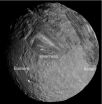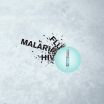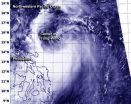(Press-News.org) Boulder, Colo., USA – Miranda, a small, icy moon of Uranus, is one of the most visually striking and enigmatic bodies in the solar system. Despite its relatively small size, Miranda appears to have experienced an episode of intense resurfacing that resulted in the formation of at least three remarkable and unique surface features -- polygonal-shaped regions called coronae.
These coronae are visible in Miranda's southern hemisphere, and each one is at least 200 km across. Arden corona, the largest, has ridges and troughs with up to 2 km of relief. Elsinore corona has an outer belt that is approx. 80 km wide, relatively smooth, and elevated above the surrounding terrain by approx. 100 m. Inverness corona has a trapezoidal shape with a large, bright chevron at its center. The northern hemisphere of Miranda was never imaged by the Voyager 2 spacecraft, so it is unknown whether additional coronae exist.
Using numerical models, Noah Hammond and Amy Barr show that convection in Miranda's ice mantle likely formed the coronae. During convection, warm buoyant ice rose toward the surface, driving concentric surface extension beneath the locations of the coronae, causing the formation of extensional tectonic faults. This style of resurfacing is similar to plate tectonics on Earth, in that convection is a primary driving force for surface deformation.
Hammond and Barr write that the internal energy that powered convection probably came from tidal heating. Tidal heating would have occurred when Miranda was in an eccentric orbit -- moving closer to and further from Uranus. This caused the tidal forces from Uranus to vary, periodically stretching and squeezing Miranda and generating heat in its ice shell. Hammond and Barr find that convection powered by tidal heating explains the locations of the coronae, the deformation patterns within the coronae, and the estimated heat flow during corona formation.
FEATURED ARTICLE
Global resurfacing of Uranus's moon Miranda by convection
Noah P. Hammond and Amy C. Barr, Dept. of Geological Sciences, Brown University, 324 Brook Street, Providence, Rhode Island 02912, USA. Published online ahead of print on 16 Sept. 2014; http://dx.doi.org/10.1130/G36124.1.
Other recently posted GEOLOGY articles (see below) cover such topics as
1. The 2004-2008 Mount St. Helens eruptions;
2. The largest landslides on Earth; and
3. The East African Rift Valley.
GEOLOGY articles published online ahead of print can be accessed online at http://geology.gsapubs.org/content/early/recent. All abstracts are open-access at http://geology.gsapubs.org/; representatives of the media may obtain complimentary articles by contacting Kea Giles at the address above.
Please discuss articles of interest with the authors before publishing stories on their work, and please make reference to GEOLOGY in articles published. Contact Kea Giles for additional information or assistance.
Non-media requests for articles may be directed to GSA Sales and Service, gsaservice@geosociety.org.
Pathways for degassing during the lava dome eruption of Mount St. Helens 2004–2008
H. Elizabeth Gaunt et al., Rock & Ice Physics Laboratory, Dept. of Earth Sciences, University College London, London WC1E 6BT, UK. Published online ahead of print on 16 Sept. 2014; http://dx.doi.org/10.1130/G35940.1.
Scientists studying the 2004-2008 Mount St. Helens eruptions found that gas dissolved in the magma escaped vertically through fractured rock near the outer rim of the volcano, acting as a valve to release pressure and reducing the likelihood of explosive eruptions. The findings contrast with previous models that showed gas escaping horizontally through volcano walls and so will help scientists better understand the different escape routes of gas and the important roles that permeability and direction of flow play. The explosive potential of volcanoes is primarily controlled by the quantity of gas in the magma and its ability to escape, often from solidified magma through a network of interlinked cracks. How easily gas escapes is termed "permeability." The study measured the permeability of rock samples taken across a lava spine, from core to outer rim. Rocks were more permeable at the outer rim compared to the core of the volcano and the level of permeability varied with direction of flow -- vertical values were up to 1000 times greater than horizontal values. This NERC-funded study was led by UCL Earth Sciences' Rock & Ice Physics Laboratory with support from UCL's Institute for Risk & Disaster Reduction and USGS Cascades Volcano Observatory.
Catastrophic emplacement of the gigantic Markagunt gravity slide, southwest Utah (USA): Implications for hazards associated with sector collapse of volcanic fields
David B. Hacker et al., Dept. of Geology, Kent State University, Kent, Ohio 44242, USA. Published online ahead of print on 16 Sept. 2014; http://dx.doi.org/10.1130/G35896.1.
Large-scale landslides that were formed by partial collapse of volcanic edifices are among the most hazardous events associated with volcanoes. However, wholesale collapse of large sections of a volcanic field containing multiple volcanoes is less well known, due partly to the huge scale of such gravity-slide features. This study by David Hacker and colleagues describes the geometry and internal features of the newly recognized Markagunt gravity slide of southwest Utah. The Markagunt gravity slide occurred 21 to 22 million years ago as a result of failure during magmatic doming of the southwest flank of the Oligocene to Miocene Marysvale volcanic field. The gravity slide is more than 90 km long, extends over more than 3,400 square kilometers, and advanced more than 30 km over the Miocene land surface. The presence of a basal zone of breccia with clastic dikes, and pseudotachylyte along secondary shear planes, provide strong evidence of catastrophic emplacement. The Markagunt gravity slide, along with the comparable Heart Mountain gravity slide in northwest Wyoming, constitutes a class of sector collapse structures not widely recognized within modern volcanic fields. Although gigantic catastrophic collapses of volcanic fields such as these are rare, they represent the largest known continental landslides on Earth and provide new insight concerning potential hazards associated with volcanic field development.
East African lake evidence for Pliocene millennial-scale climate variability
Katy E. Wilson et al., Dept. of Earth Sciences, University College London, London WC1E 6BT, UK. Published online ahead of print on 16 Sept. 2014; http://dx.doi.org/10.1130/G35915.1.
The East African Rift Valley is often considered to be the "Cradle of Mankind," where hominin species evolved and diversified over the last few million years. Around 2 to 2.5 million years ago, the evolution of the genus Homo was accompanied by the use of stone tools and an increase in brain size. Ancient lake sediments from central Kenya indicate that around 2.5 million years ago, parts of the Rift Valley were occupied by large, deep-water lakes, which appeared and disappeared regularly through time. Authors Katy E. Wilson and colleagues look in detail at one of these lakes and find that the lake formed very quickly and disappeared more gradually. Variations in the chemical composition of nannofossils preserved in these sediments indicate that the lake itself varied greatly on millennial timescales. Wilson and colleagues interpret these fluctuations as changes in regional climate and in the strength of the local rainy seasons. The timing of these changes is very similar to the timing of events observed in ice core records from Greenland since the last ice age. These results show that this key period of human evolution likely coincided with a time when the local climate was highly variable.
Magmatic life at low Reynolds number
Allen F. Glazner, Dept. of Geological Sciences, University of North Carolina, Chapel Hill, North Carolina 27599-3315, USA. Published online ahead of print on 16 Sept. 2014; http://dx.doi.org/10.1130/G36078.1.
Many eye-catching features in granites, such as mineral layering and accumulations of large crystals, have traditionally been explained by analogy to layering in sedimentary rocks; that is, as a result of crystals being swept along by currents in a magma chamber. However, simple physical arguments and comparison to the physical environment of microorganisms demonstrate that this cannot be true. Commonplace granitic
Remnants of ancient Australia in Vanuatu: Implications for crustal evolution in island arcs and tectonic development of the southwest Pacific
Janrich Buys et al. (corresponding: Carl Spandler), School of Earth and Environmental Sciences, James Cook University, Townsville 4811, Australia. Published online ahead of print on 16 Sept. 2014; http://dx.doi.org/10.1130/G36155.1.
Volcanic island chains located far from continental landmasses are considered idea sites to study how new crust is formed, as the influence of pre-existing continental crust is assumed to be negligible. In this study, Janrich Buys and colleagues use the age of zircon grains included in volcanic rocks from Vanuatu to show that ancient continental material is part of the basement geology of the Vanuatu island arc. This continental material was transported thousands of kilometers from northern Australia to Vanuatu sometime prior to the Cenozoic Era. Incorporation of this old continental material into magmas that subsequently transit through the crust can modify the chemical composition of the magma in a manner that would normally be ascribed to recycling of crustal components due to subduction processes. Therefore, these results highlight the need for caution in interpreting the geochemistry of magmas formed in oceanic settings. The recognition of Australian crust in Vanuatu also impacts on tectonic models of the southwest Pacific, as it implies that fragmentation of the east Australian margin of Gondwana occurred earlier than previously thought.
Neoarchean disaggregation and reassembly of the Superior craton
Jean H. Bédard Geological Survey of Canada, 490 de la Couronne, Québec, Québec G1K 9A9, Canada; Lyal B. Harris, Institut National de la Recherche Scientifique, Centre Eau Terre Environnement, 490 de la Couronne, Québec, Québec G1K 9A9, Canada. Published online ahead of print on 16 Sept. 2014; http://dx.doi.org/10.1130/G35770.1.
A non-uniformitarian model is proposed to explain the architecture and origin of the Superior craton, Canadian Shield. The model proposes that a mantle overturn event starting at approx. 2.8 billion years ago partially disaggregated an older composite craton. The up- and outwelling mantle flow tore ribbon-continents away from the southern margin of this older craton, creating narrow oceanic tracts where uncontaminated mantle-derived melts could erupt to form volcanic belts like the Abitibi. The model proposes that the mantle flow field changed at about 2.72 billion years ago, driving the northernmost remnant continental block of this older craton towards the south and reaccreting the detached fragments and oceanic tracts to its leading edge.
INFORMATION:
http://www.geosociety.org
Miranda: An icy moon deformed by tidal heating
New Geology articles posted online ahead of print 16 Sept. 2014
2014-09-18
ELSE PRESS RELEASES FROM THIS DATE:
Research milestone in CCHF virus could help identify new treatments
2014-09-18
SAN ANTONIO, September 18, 2014 – New research into the Crimean-Congo hemorrhagic fever virus (CCHFV), a tick-borne virus which causes a severe hemorrhagic disease in humans similar to that caused by Ebolavirus, has identified new cellular factors essential for CCHFV infection. This discovery has the potential to lead to novel targets for therapeutic interventions against the pathogen.
The research, reported in a paper published today in the journal PLoS Pathogens and conducted by scientists at the Texas Biomedical Research Institute and their colleagues, represents ...
Microplastic pollution discovered in St. Lawrence River sediments
2014-09-18
A team of researchers from McGill University and the Quebec government have discovered microplastics (in the form of polyethylene 'microbeads', END ...
A new quality control pathway in the cell
2014-09-18
Proteins are important building blocks in our cells and each cell contains millions of different protein molecules. They are involved in everything from structural to regulatory aspects in the cell. Proteins are constructed as linear molecules but they only become functional once they are folded into specific three-dimensional structures. Several factors, like mutations, stress and age, can interfere with this folding process and induce protein misfolding. Accumulated misfolded proteins are toxic and to prevent this, cells have developed quality control systems just like ...
Small, fast, and crowded: Mammal traits amplify tick-borne illness
2014-09-18
(Millbrook, N.Y.) In the U.S., some 300,000 people are diagnosed with Lyme disease annually. Thousands also suffer from babesiosis and anaplasmosis, tick-borne ailments that can occur alone or as co-infections with Lyme disease. According to a new paper published in PLOS ONE, when small, fast-living mammals abound, so too does our risk of getting sick.
In eastern and central North America, blacklegged ticks are the primary vectors for Lyme disease, babesiosis, and anaplasmosis. The pathogens that cause these illnesses are widespread in nature; ticks acquire them when ...
Curcumin, special peptides boost cancer-blocking PIAS3 to neutralize STAT3 in mesothelioma
2014-09-18
A common Asian spice and cancer-hampering molecules show promise in slowing the progression of mesothelioma, a cancer of the lung's lining often linked to asbestos. Scientists from Case Western Reserve University and the Georg-Speyer-Haus in Frankfurt, Germany, demonstrate that application of curcumin, a derivative of the spice turmeric, and cancer-inhibiting peptides increase levels of a protein inhibitor known to combat the progression of this cancer. Their findings appeared in the Aug. 14 online edition Clinical Cancer Research; the print version of the article will ...
A new way to prevent the spread of devastating diseases
2014-09-18
For decades, researchers have tried to develop broadly effective vaccines to prevent the spread of illnesses such as HIV, malaria, and tuberculosis. While limited progress has been made along these lines, there are still no licensed vaccinations available that can protect most people from these devastating diseases.
So what are immunologists to do when vaccines just aren't working?
At Caltech, Nobel Laureate David Baltimore and his colleagues have approached the problem in a different way. Whereas vaccines introduce substances such as antigens into the body hoping ...
LSU Health research discovers means to free immune system to destroy cancer
2014-09-18
New Orleans, LA – Research led by Paulo Rodriguez, PhD, an assistant research professor of Microbiology, Immunology & Parasitology at LSU Health New Orleans' Stanley S. Scott Cancer Center, has identified the crucial role an inflammatory protein known as Chop plays in the body's ability to fight cancer. Results demonstrate, for the first time, that Chop regulates the activity and accumulation of cells that suppress the body's immune response against tumors. The LSU Health New Orleans research team showed that when they removed Chop, the T-cells of the immune system mounted ...
NASA sees western edge of Tropical Storm Fung-Wong affecting Philippines
2014-09-18
The NASA-NOAA Suomi NPP satellite saw the western edge of Tropical Storm Fung-Wong over the central Philippines on Sept. 18. Fung-Wong developed on Sept. 17 as Tropical Depression 16W, and strengthened into a tropical storm by 5 p.m. EDT on Sept. 17.
When NASA-NOAA's Suomi NPP satellite passed over Tropical Storm Fung-Wong on Sept. 18 at 05:24 UTC and the Visible Infrared Imaging Radiometer Suite (VIIRS) instrument aboard captured a visible picture of the storm. The VIIRS instrument revealed that a thick band of powerful thunderstorms spiraled around the southwestern ...
Study provides insight about providing private mental health service to veterans
2014-09-18
A unique partnership to support private efforts to provide mental health services to veterans and their families could provide a model for similar efforts should federal officials decide to expand privately provided health care as part of reform of the VA health system, according to a new RAND Corporation report.
The Welcome Back Veterans Initiative, a joint project of philanthropic groups and major academic medical centers, has provided an array of patient care, education and other services to veterans and their families.
Backed by Major League Baseball and the Robert ...
Benefits of telecommuting greater for some workers, study finds
2014-09-18
CHAMPAIGN, Ill. — Even in a hyperconnected world where laptops, phones, tablets and now even wristwatches are tethered to the Internet 24/7, employers are still wary about the performance and social costs imposed by employees who work remotely.
But a new study by a University of Illinois business professor says telecommuting yields positive effects for two important measures of employee performance, and it can even produce very strong positive effects under certain circumstances for some employees.
According to Ravi S. Gajendran, a professor of business administration ...
LAST 30 PRESS RELEASES:
The impact of family dynamics on eating behaviour – how going home for Christmas can change how you eat
Tracing the quick synthesis of an industrially important catalyst
New software sheds light on cancer’s hidden genetic networks
UT Health San Antonio awarded $3 million in CPRIT grants to bolster cancer research and prevention efforts in South Texas
Third symposium spotlights global challenge of new contaminants in China’s fight against pollution
From straw to soil harmony: International team reveals how biochar supercharges carbon-smart farming
Myeloma: How AI is redrawing the map of cancer care
Manhattan E. Charurat, Ph.D., MHS invested as the Homer and Martha Gudelsky Distinguished Professor in Medicine at the University of Maryland School of Medicine
Insilico Medicine’s Pharma.AI Q4 Winter Launch Recap: Revolutionizing drug discovery with cutting-edge AI innovations, accelerating the path to pharmaceutical superintelligence
Nanoplastics have diet-dependent impacts on digestive system health
Brain neuron death occurs throughout life and increases with age, a natural human protein drug may halt neuron death in Alzheimer’s disease
SPIE and CLP announce the recipients of the 2025 Advanced Photonics Young Innovator Award
Lessons from the Caldor Fire’s Christmas Valley ‘Miracle’
Ant societies rose by trading individual protection for collective power
Research reveals how ancient viral DNA shapes early embryonic development
A molecular gatekeeper that controls protein synthesis
New ‘cloaking device’ concept to shield sensitive tech from magnetic fields
Researchers show impact of mountain building and climate change on alpine biodiversity
Study models the transition from Neanderthals to modern humans in Europe
University of Phoenix College of Doctoral Studies releases white paper on AI-driven skilling to reduce burnout and restore worker autonomy
AIs fail at the game of visual “telephone”
The levers for a sustainable food system
Potential changes in US homelessness by ending federal support for housing first programs
Vulnerability of large language models to prompt injection when providing medical advice
Researchers develop new system for high-energy-density, long-life, multi-electron transfer bromine-based flow batteries
Ending federal support for housing first programs could increase U.S. homelessness by 5% in one year, new JAMA study finds
New research uncovers molecular ‘safety switch’ shielding cancers from immune attack
Bacteria resisting viral infection can still sink carbon to ocean floor
Younger biological age may increase depression risk in older women during COVID-19
Bharat Innovates 2026 National Basecamp Showcases India’s Most Promising Deep-Tech Ventures
[Press-News.org] Miranda: An icy moon deformed by tidal heatingNew Geology articles posted online ahead of print 16 Sept. 2014




